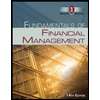
Concept explainers
Integrative: Risk and valuation Hamlin Steel Company wishes to determine the value of Craft Foundry, a firm that it is considering acquiring for cash. Hamlin wishes to determine the applicable discount rate to use as an input to the constant-growth valuation model. Craft’s stock is not publicly traded. After studying the required returns of firms similar to Craft that are publicly traded, Hamlin believes that an appropriate risk premium on Craft stock is about 9%. The risk-free rate is currently 5%. Craft's dividend per share for each of the past 6 years is shown in the following table.
| Year | Dividend per share |
| 2019 | $3.44 |
| 2018 | 3.28 |
| 2017 | .15 |
| 2016 | 2.90 |
| 2015 | 2.75 |
| 2014 | 2.45 |
- a. Given that Craft is expected to pay a dividend of $3.68 next year, determine the maximum cash price that Hamlin should pay for each share of Craft.
- b. Describe the effect on the resulting value of Craft of
- 1. A decrease in its
dividend growth rate of 2% from that exhibited over the 2014-2019 period. - 2. A decrease in its risk premium to 4%.
- 1. A decrease in its
Want to see the full answer?
Check out a sample textbook solution
Chapter 7 Solutions
Gitman: Principl Manageri Finance_15 (15th Edition) (What's New in Finance)
Additional Business Textbook Solutions
Financial Accounting (12th Edition) (What's New in Accounting)
Horngren's Accounting (12th Edition)
Auditing And Assurance Services
Financial Accounting: Tools for Business Decision Making, 8th Edition
Business Essentials (12th Edition) (What's New in Intro to Business)
Gitman: Principl Manageri Finance_15 (15th Edition) (What's New in Finance)
- A flowchart that depicts the relationships among the input, processing, and output of an AIS is A. a system flowchart. B. a program flowchart. C. an internal control flowchart. D. a document flowchart.arrow_forwardA flowchart that depicts the relationships among the input, processing, and output of an AIS is A. a system flowchart. B. a program flowchart. C. an internal control flowchart. D. a document flowchart.arrow_forwardPlease write proposal which needs On the basis of which you will be writing APR. Write review of at least one article on the study area (Not title) of your interest, which can be finance related study area. Go through the 1. Study area selection (Topic Selection) 2. Review of Literature and development of research of framework 3. Topic Selection 4. Further review of literature and refinement of research fraework 5. Problem definition and research question…arrow_forward
- Let it denote the effective annual return achieved on an equity fund achieved between time (t-1) and time t. Annual log-returns on the fund, denoted by In(1+i̟²), are assumed to form a series of independent and identically distributed Normal random variables with parameters µ = 7% and σ = 10%. An investor has a liability of £20,000 payable at time 10. Calculate the amount of money that should be invested now so that the probability that the investor will be unable to meet the liability as it falls due is only 5%. Express your answer to the NEAREST INTEGER and do NOT include a "£" sign. Note: From standard Normal tables, we have (-1.645) = 0.05.arrow_forwardFor this question, use this data: myFunc = function (x, y = 2) {z = 7 Z+x^2+y } What is the output of myFunc(2)? O 13. O An error, y is undefined. O Nothing, we have to assign it as a vari O 9.arrow_forwarda medical test has some probability of being positive if the patient has the disease (hasPos) and another probability of testing positive if the person does not have the disease (notHasPos). a random member of the entire population has a real problem of having the disease (actual incidence). Based on the attached information what does the result of the function?arrow_forward
- myFunc = function (x, y = 2) {z = 7 } z+x^2+y Assuming that this was the first thing entered in a new R session, if the next command entered is z+1, what is the output? O 8. ● An error, z does not exist. O 10. O 7.arrow_forwardDon't used Ai solutionarrow_forwardLiterature Review Based Essay on Contemporary Issues of Business Ethics and Corporate Social Responsibility Essay Format Cover Page with your Name Table of Content • Introduction ⚫ Objectives ⚫ Discussion with Literature Support • Conclusion References (10+) Words Limit-3000-3500 wordsarrow_forward
- Please don't use hand ratingarrow_forward"Dividend paying stocks cannot be growth stocks" Do you agree or disagree? Discuss choosing two stocks to help justify your view.arrow_forwardA firm needs to raise $950,000 but will incur flotation costs of 5%. How much will it pay in flotation costs? Multiple choice question. $55,500 $50,000 $47,500 $55,000arrow_forward
 Fundamentals of Financial Management (MindTap Cou...FinanceISBN:9781285867977Author:Eugene F. Brigham, Joel F. HoustonPublisher:Cengage Learning
Fundamentals of Financial Management (MindTap Cou...FinanceISBN:9781285867977Author:Eugene F. Brigham, Joel F. HoustonPublisher:Cengage Learning Fundamentals of Financial Management (MindTap Cou...FinanceISBN:9781337395250Author:Eugene F. Brigham, Joel F. HoustonPublisher:Cengage Learning
Fundamentals of Financial Management (MindTap Cou...FinanceISBN:9781337395250Author:Eugene F. Brigham, Joel F. HoustonPublisher:Cengage Learning
 Financial Reporting, Financial Statement Analysis...FinanceISBN:9781285190907Author:James M. Wahlen, Stephen P. Baginski, Mark BradshawPublisher:Cengage Learning
Financial Reporting, Financial Statement Analysis...FinanceISBN:9781285190907Author:James M. Wahlen, Stephen P. Baginski, Mark BradshawPublisher:Cengage Learning EBK CONTEMPORARY FINANCIAL MANAGEMENTFinanceISBN:9781337514835Author:MOYERPublisher:CENGAGE LEARNING - CONSIGNMENT
EBK CONTEMPORARY FINANCIAL MANAGEMENTFinanceISBN:9781337514835Author:MOYERPublisher:CENGAGE LEARNING - CONSIGNMENT




